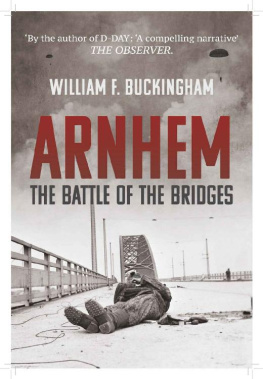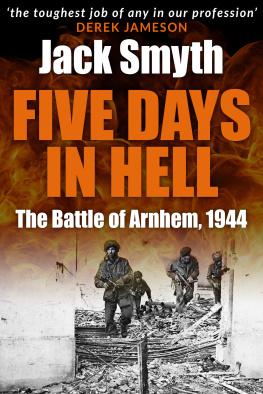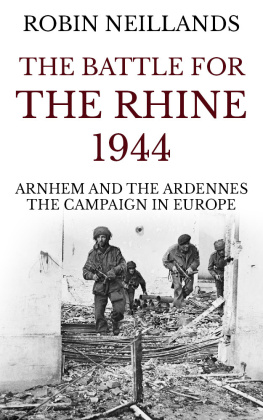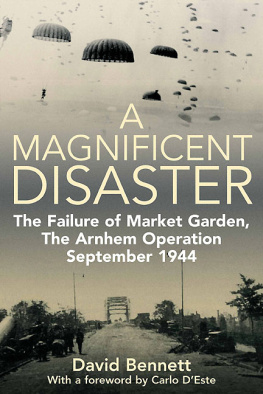Buckingham - Arnhem: the battle of the bridges: September 1944
Here you can read online Buckingham - Arnhem: the battle of the bridges: September 1944 full text of the book (entire story) in english for free. Download pdf and epub, get meaning, cover and reviews about this ebook. City: Netherlands;Arnhem, year: 2014;2019, publisher: Amberley Publishing, genre: Non-fiction. Description of the work, (preface) as well as reviews are available. Best literature library LitArk.com created for fans of good reading and offers a wide selection of genres:
Romance novel
Science fiction
Adventure
Detective
Science
History
Home and family
Prose
Art
Politics
Computer
Non-fiction
Religion
Business
Children
Humor
Choose a favorite category and find really read worthwhile books. Enjoy immersion in the world of imagination, feel the emotions of the characters or learn something new for yourself, make an fascinating discovery.
- Book:Arnhem: the battle of the bridges: September 1944
- Author:
- Publisher:Amberley Publishing
- Genre:
- Year:2014;2019
- City:Netherlands;Arnhem
- Rating:3 / 5
- Favourites:Add to favourites
- Your mark:
- 60
- 1
- 2
- 3
- 4
- 5
Arnhem: the battle of the bridges: September 1944: summary, description and annotation
We offer to read an annotation, description, summary or preface (depends on what the author of the book "Arnhem: the battle of the bridges: September 1944" wrote himself). If you haven't found the necessary information about the book — write in the comments, we will try to find it.
Arnhem: the battle of the bridges: September 1944 — read online for free the complete book (whole text) full work
Below is the text of the book, divided by pages. System saving the place of the last page read, allows you to conveniently read the book "Arnhem: the battle of the bridges: September 1944" online for free, without having to search again every time where you left off. Put a bookmark, and you can go to the page where you finished reading at any time.
Font size:
Interval:
Bookmark:


As ever, for those who were there and especially those who did not come back
First published 2019
Amberley Publishing
The Hill, Stroud
Gloucestershire, GL5 4EP
www.amberley-books.com
Copyright William F. Buckingham, 2019
The right of William F. Buckingham to be identified as the Author of this work has been asserted in accordance with the Copyrights, Designs and Patents Act 1988.
All rights reserved. No part of this book may be reprinted or reproduced or utilised in any form or by any electronic, mechanical or other means, now known or hereafter invented, including photocopying and recording, or in any information storage or retrieval system, without the permission in writing from the Publishers.
British Library Cataloguing in Publication Data.
A catalogue record for this book is available from the British Library.
ISBN 9781848681095 (PRINT)
ISBN 9781445637167 (eBOOK)
Origination by Amberley Publishing.
Printed in the UK.
On Sunday 17 September 1944, two thousand and twenty-three transport aircraft and four hundred and seventy-eight gliders lifted off from airfields across southern and eastern England carrying troops from the US 82nd and 101st Airborne Divisions and the British 1st Airborne Division. They were the first lift of the largest Airborne operation in history, Operation MARKET, which was intended to open a sixty-mile corridor across five major water obstacles for Allied ground forces, codenamed GARDEN, running from the Belgian border to the Dutch city of Arnhem on the Lower Rhine. The equivalent of a Battalion managed to secure the north end of the road bridge in Arnhem, where they were cut off and overrun after fighting for three days and four nights against overwhelming odds; the remainder of the 1st Airborne Division was all but destroyed in futile attempts to reach them and then holding on for nine days at Oosterbeek. The GARDEN ground force took six days rather than the scheduled forty-eight hours to reach the south bank of the Lower Rhine west of Arnhem and after a token attempt at reinforcement assisted in evacuating approximately 2,500 of the 1st Airborne Divisions survivors across the river on the night of 25-26 September 1944. They left behind well over a thousand Airborne dead and over six thousand wounded and Prisoners of War in addition to the similar numbers of dead and wounded sustained by the 82nd and 101st Airborne Divisions in forcing the Airborne Corridor and keeping it open.
The deserved elevation of the Battle of Arnhem to legendary status began virtually as soon as 1st Airborne Divisions survivors had been evacuated across the Lower Rhine. Within two years the feature film Theirs is the Glory had been shot in the ruins of Oosterbeek starring men who had participated in the battle, and in the seventy-two years since then another Hollywood feature film, dozens of books and several television documentaries dealing with the battle have appeared; viewing A Bridge Too Far during a family holiday on the Isle of Wight in the year it was released was the present authors introduction to the Battle of Arnhem. As one would expect with this degree of coverage, the course of events that led up to MARKET GARDEN and during the fighting at Arnhem and Oosterbeek have been largely established, and most of the factors that contributed to the failure of MARKET GARDEN have been at least identified, along with a few canards and red herrings; the latter include the enduring myth that the 1st Airborne Division descended upon two fully equipped and functioning SS Panzer Divisions, for example. The present author was still working on his PhD on the establishment and initial development of British Airborne Forces when invited to write his first book on Arnhem in 2000, but research soon revealed clear similarities between the two, insofar as popular perceptions were somewhat at variance with the verifiable reality. Thus while the spectacular bare bones of what happened in Holland in September 1944 had been fairly clearly established, a great deal more was missing or had gone unremarked. As with any undertaking on the scale of MARKET GARDEN there were a myriad of factors that contributed to failure but while most have been acknowledged, in some instances they have been slanted subtly for camouflage and in others simply hidden in plain sight. It is popularly assumed the 1st Airborne Division failed to reach its objectives because of enemy action for example, whereas the root of the problem was actually poor leadership and planning at the Division and Brigade level; similarly the tardiness of 30 Corps advance, and specifically that of the Guards Armoured Division, is routinely excused on the grounds of enemy resistance and poor terrain, but were actually proven to be due to lack of application, rigid and inappropriate operating procedures and contradictory operational instructions from Corps level. All this was apparent from a relatively superficial analysis of official accounts and secondary sources, but subsequent in-depth research in primary source material and especially the operational records across the last nine years not only conclusively proved this was the case, but also revealed that the litany of poor planning, leadership and decision making was actually much worse than suspected.
This work therefore builds upon the foundation of the present authors 2001 work on the Battle of Arnhem by providing a more in-depth account of not just the nine days of the battle but of the events and strategic developments that led to Operation MARKET GARDEN, and the planning and other decisions that resulted in it being executed in the way it was. In addition, the extensive use of primary source material, specifically unit War Diaries, permits the construction of a much more detailed narrative from Platoon to Corps level than has been provided hitherto, leavened with participant accounts for additional detail. This in turn permits focussed analysis that explains why events unfolded as they did, and in the process reveals who and what was responsible for key decisions and the ramifications thereof and not just to allow the superficial assigning of responsibility; this also reveals a host of extraordinary men at all levels doing extraordinary things as if they were merely routine, many of them at the cost of their lives. In addition, the narrative is augmented with material from the German side for clarity and balance along with detailed examination of the activities of the two US Airborne Divisions up to the point where they put the GARDEN force across the River Waal at Nijmegen. Although the US contribution was absolutely vital in both the front-line fighting and the transport spheres, it does not always receive the acclaim it merits from the British perspective; while the 1st Airborne Division was tasked to secure two permanent crossings over a single watercourse, its US equivalents were tasked to secure twelve crossings over seven watercourses and succeeded in securing and holding the majority of them, for example. In short, the aim is to show what happened, when it happened and why it happened as it did.
In closing I should like to thank Mr Henk Capelle from Oosterbeek for providing me with a copy of his wartime memoir, other local material and correcting some of my misunderstandings; Richard Anderson of the TankNet Internet Military Forum for providing the US Army Advanced Officer Course monographs; George F. Cholewczynski for kindly providing me with a copy of his work and permission to quote therefrom; Stephen King for the always stimulating discussion on the Arnhem landing zones and providing me with numerous items of material; Mr William J. Stone, formerly of the 321st Glider Field Artillery Battalion 101st Airborne Division, for providing me with a copy of his unpublished memoir; William McVean for keeping me informed of matters connected to the 23rd Field Company RCE and Russell Kennedy for kindly providing me with a copy of his work on that unit; Jonathan Reeve and his successors at Amberley for their forbearance with my somewhat elastic approach to deadlines; and last but not least my wife Aileen once again for her patience, forbearance in putting up with it all and her toleration of research diversions whilst supposedly on holiday. Finally, all opinions, conclusions, errors, misconceptions and mistakes are entirely my own.
Font size:
Interval:
Bookmark:
Similar books «Arnhem: the battle of the bridges: September 1944»
Look at similar books to Arnhem: the battle of the bridges: September 1944. We have selected literature similar in name and meaning in the hope of providing readers with more options to find new, interesting, not yet read works.
Discussion, reviews of the book Arnhem: the battle of the bridges: September 1944 and just readers' own opinions. Leave your comments, write what you think about the work, its meaning or the main characters. Specify what exactly you liked and what you didn't like, and why you think so.
















